Elongated triangular tiling
| Elongated triangular tiling | |
|---|---|
 | |
| Type | Semiregular tiling |
| Vertex configuration | 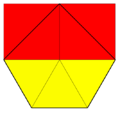 3.3.3.4.4 |
| Schläfli symbol | {3,6}:e s{∞}h1{∞} |
| Wythoff symbol | 2 | 2 (2 2) |
| Coxeter diagram | |
| Symmetry | cmm, [∞,2+,∞], (2*22) |
| Rotation symmetry | p2, [∞,2,∞]+, (2222) |
| Bowers acronym | Etrat |
| Dual | Prismatic pentagonal tiling |
| Properties | Vertex-transitive |
In geometry, the elongated triangular tiling is a semiregular tiling of the Euclidean plane. There are three triangles and two squares on each vertex. It is named as a triangular tiling elongated by rows of squares, and given Schläfli symbol {3,6}:e.
Conway calls it a isosnub quadrille.[1]
There are 3 regular and 8 semiregular tilings in the plane. This tiling is similar to the snub square tiling which also has 3 triangles and two squares on a vertex, but in a different order.
Construction
It is also the only uniform tiling that can't be created as a Wythoff construction. It can be constructed as alternate layers of apeirogonal prisms and apeirogonal antiprisms.
Uniform colorings
There is one uniform colorings of an elongated triangular tiling. Two 2-uniform colorings have a single vertex figure, 11123, with two colors of squares, but are not 1-uniform, repeated either by reflection or glide reflection, or in general each row of squares can be shifted around independently. The 2-uniform tilings are also called Archimedean colorings. There are infinite variations of these Archimedean colorings by arbitrary shifts in the square row colorings.
| 11122 (1-uniform) | 11123 (2-uniform or 1-Archimedean) | |
|---|---|---|
 |
 |
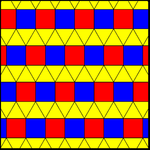 |
| cmm (2*22) | pmg (22*) | pgg (22×) |
Circle packing
The elongated triangular tiling can be used as a circle packing, placing equal diameter circles at the center of every point. Every circle is in contact with 5 other circles in the packing (kissing number).[2]
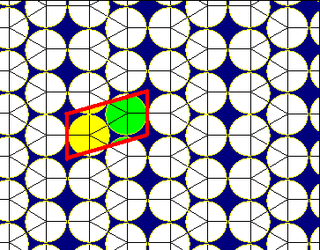
Related tilings
It is first in a series of symmetry mutations[3] with hyperbolic uniform tilings with 2*n2 orbifold notation symmetry, vertex figure 4.n.4.3.3.3, and Coxeter diagram ![]()
![]()
![]()
![]()
![]()
![]()
![]() . Their duals have hexagonal faces in the hyperbolic plane, with face configuration V4.n.4.3.3.3.
. Their duals have hexagonal faces in the hyperbolic plane, with face configuration V4.n.4.3.3.3.
| 4.2.4.3.3.3 | 4.3.4.3.3.3 | 4.4.4.3.3.3 |
|---|---|---|
| 2*22 | 2*32 | 2*42 |
 |
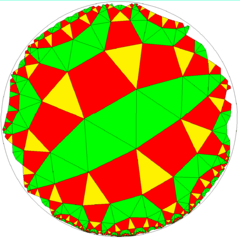 |
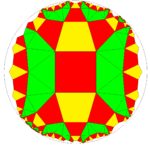 |
There are four related 2-uniform tilings, mixing 2 or 3 rows of triangles or squares.[4][5]
| Double elongated | Triple elongated | Half elongated | One third elongated |
|---|---|---|---|
 |
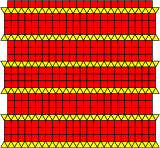 |
 |
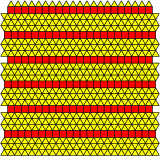 |
Prismatic pentagonal tiling
| Prismatic pentagonal tiling | |
|---|---|
 | |
| Type | Dual uniform tiling |
| Coxeter diagram | |
| Faces | irregular pentagons |
| Face configuration | V3.3.3.4.4 |
| Symmetry group | cmm, [∞,2+,∞], (2*22) |
| Rotation group | p2, [∞,2,∞]+, (2222) |
| Dual | Elongated triangular tiling |
| Properties | face-transitive |
The prismatic pentagonal tiling is a dual uniform tiling in the Euclidean plane. It is one of 15 known isohedral pentagon tilings. It can be seen as a stretched hexagonal tiling with a set of parallel bisecting lines through the hexagons.
Conway calls it a iso(4-)pentille.[1] Each of its pentagonal faces has three 120° and two 90° angles.
It is related to the Cairo pentagonal tiling with face configuration V3.3.4.3.4.
Geometric variations
Monohedral pentagonal tiling type 6 has the same topology, but two edge lengths and a lower p2 (2222) wallpaper group symmetry:
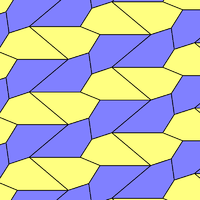 |
 a=d=e, b=c B+D=180°, 2B=E |
Related 2-uniform dual tilings
There are four related 2-uniform dual tilings, mixing in rows of squares or hexagons.
 |
 |
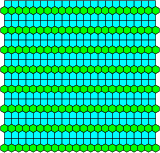 |
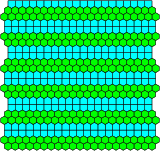 |
See also
- Tilings of regular polygons
- Elongated triangular prismatic honeycomb
- Gyroelongated triangular prismatic honeycomb
Notes
- 1 2 Conway, 2008, p.288 table
- ↑ Order in Space: A design source book, Keith Critchlow, p.74-75, circle pattern F
- ↑ Two Dimensional symmetry Mutations by Daniel Huson
- ↑ Chavey, D. (1989). "Tilings by Regular Polygons—II: A Catalog of Tilings". Computers & Mathematics with Applications. 17: 147–165. doi:10.1016/0898-1221(89)90156-9.
- ↑ http://www.uwgb.edu/dutchs/symmetry/uniftil.htm
References
| Wikimedia Commons has media related to Uniform tiling 3-3-3-4-4. |
| Wikimedia Commons has media related to Prismatic pentagonal tiling. |
- Grünbaum, Branko ; and Shephard, G. C. (1987). Tilings and Patterns. New York: W. H. Freeman. ISBN 0-7167-1193-1. (Chapter 2.1: Regular and uniform tilings, p. 58-65)
- Williams, Robert (1979). The Geometrical Foundation of Natural Structure: A Source Book of Design. Dover Publications, Inc. ISBN 0-486-23729-X. p37
- John H. Conway, Heidi Burgiel, Chaim Goodman-Strass, The Symmetries of Things 2008, ISBN 978-1-56881-220-5
- Keith Critchlow, Order in Space: A design source book, 1970, p. 69-61, Pattern Q2, Dual p. 77-76, pattern 6
- Dale Seymour and Jill Britton, Introduction to Tessellations, 1989, ISBN 978-0866514613, pp. 50–56
External links
- Klitzing, Richard. "2D Euclidean tilings elong( x3o6o ) - etrat - O4".
